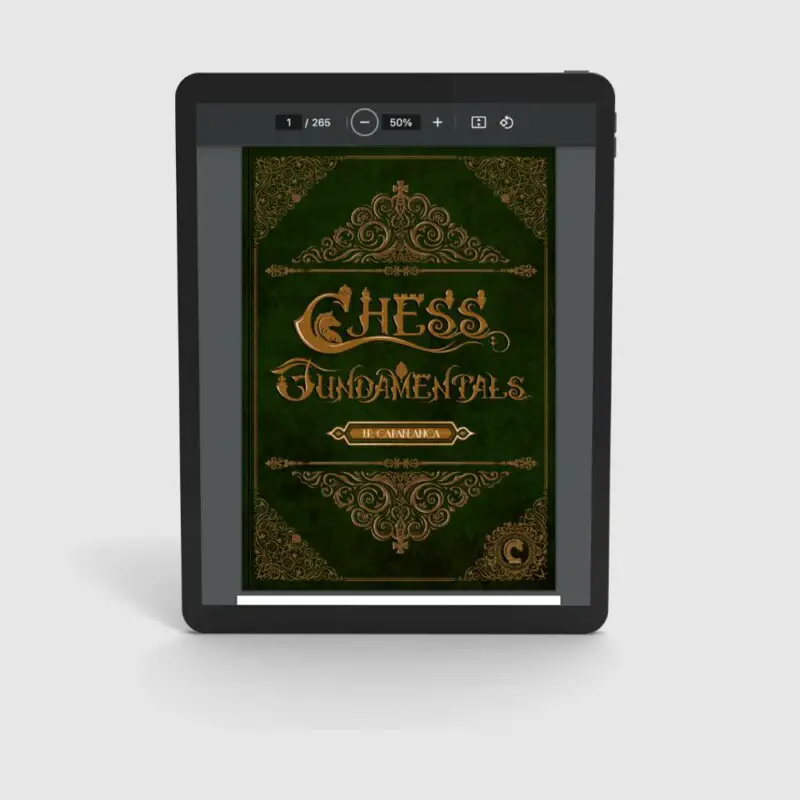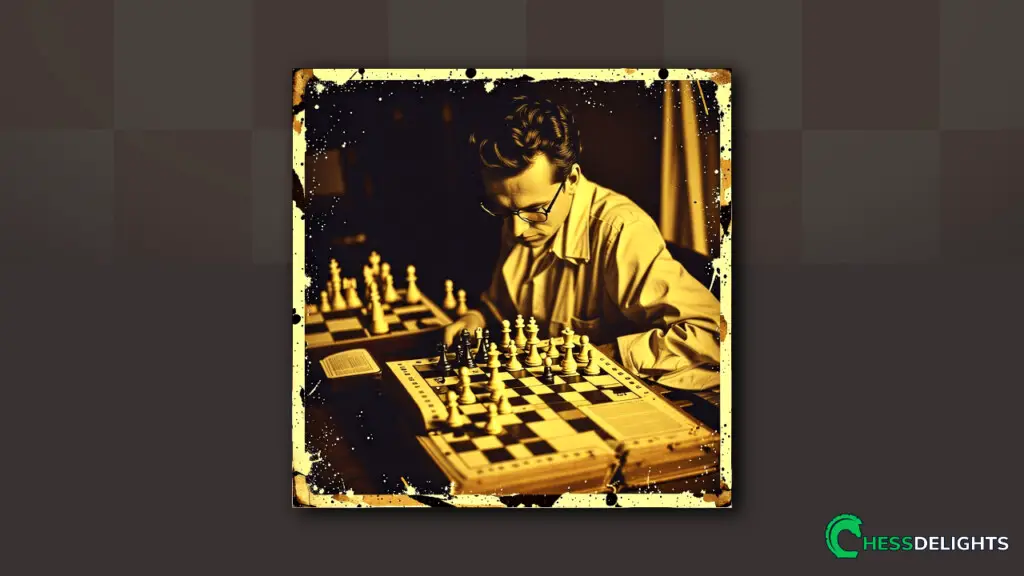When it comes to chess literature, few books have stood the test of time as effectively as “Chess Fundamentals” by Jose Raul Capablanca.
And I believe many of you have heard about this timeless classic chess book.
As someone who's thoroughly read and practiced this book, I can assure you that it's remarkably effective for any chess lover, be it a beginner, intermediate player, or even professional!
This classic work, written by a former World Chess Champion, continues to be an indispensable resource for those who wish to delve deeper into the strategic world of chess.
But most individuals who see the book and its title would likely assume that it only explains the basic aspects of chess (which is very much not true…).
The book primarily focuses on mastering the strategic fundamental principles essential for winning a chess game.
From my experience, it effectively illustrates the key chess strategies for securing victory in scenarios commonly faced during real gameplay.
Now, the purpose of this article is to provide you a comprehensive understanding of the effectiveness of the Chess Fundamentals book, its appropriate use, and the suitable Elo rating for its readers.
We will also explore the best way to read this book effectively, its extent in terms of pages, the legend behind its creation, and where you can purchase this invaluable chess book.
Welcome to Chess Fundamentals review of the Capablanca Chess Book. Let's start!
Table of Contents
How Effective Is Chess Fundamentals Book
Right off the bat, Capablanca's approachable and friendly writing style makes ‘Chess Fundamentals' a joy to read.
He breaks down the complex game of chess into understandable chunks, making it easier for readers to grasp the intricacies of the game.
The book is structured into various chapters, each diving into a specific aspect of the game.
It covers a range of topics from basic chess rules, positional play, and endgame strategies to more complex notions such as the importance of pawn structure and the art of combination.
Below are the chapters and my overview for each:
Recommended : If you want to know where to start your chess journey, go to this page.
Chapter 1: First Principles: Endings, Middle-Game and Openings.
The first chapter is titled “First Principles: Endings, Middle-game and Openings.” It delves into the three significant phases of a chess game: the opening, the middle game, and the ending.
This chapter emphasizes the importance of understanding and mastering these three phases to improve one's overall performance in the game. It explores how each phase requires different strategies and tactics, and knowing when and how to apply them can significantly influence the game's outcome.
The book provides comprehensive strategies, examples, and detailed explanations to help readers understand these principles better.
It also provides practical advice on how to develop and implement effective strategies during each phase of the game.
This chapter, therefore, serves as a foundation for the subsequent chapters that elaborate on these principles in greater detail.
Chapter 2: Further Principles in End-Game Play
Building upon the knowledge from the previous chapter, Chapter 2: Further Principles in End-game Play, delves deeper into the intricate strategies of the end-game phase.
This section provides a meticulous exploration of various endgame concepts, such as the significance of king's positioning, the importance of passed pawns, and the critical role of piece activity in the endgame. It highlights the fact that the king, often a defensive piece in the early stages of the game, becomes a powerful weapon in the endgame.
Moreover, the chapter underscores the value of pawn promotion, which can often lead to a decisive advantage in the endgame. It discusses the various tactics to either promote a pawn or to prevent an opponent from doing so.
What I've learned in this chapter, Capablanca chess fundamentals in endgame delves into the principle of piece activity. It demonstrates through numerous examples that even a slight advantage in activity can often compensate for a material deficit.
If you want to improve your endgame this chapter will help you understand it really well, mastery of these concepts can significantly enhance your ability to win games.
Recommended reading: If you want to read more about the chess fundamentals principles from the book go to this article.
Chapter 3: Planning a Win in Middle-Game Play
Having delved into the essential principles of end-game play, the focus now shifts to the often complex and incredibly strategic area of the middle game. This pivotal stage in the game of chess is explored in Chapter 3: Planning a Win in Middle-game Play.
The middle game often sets the stage for the final outcome, and a well-planned strategy can lead to a decisive victory.
It is during this stage where the most complex battles are fought, and the most intricate strategies are woven. This chapter provides an in-depth examination of planning a winning strategy during the middle game.
The elements discussed range from the development of pieces to the control of the center, creating potential for attacks and exploiting weaknesses in the opponent's game. It provides strategies for launching successful attacks and conducting effective defenses. The importance of pawn structures, space control, and tactical combinations are also explored.
Illustrative examples from historical chess matches are utilized to demonstrate these principles in action, to assist in understanding their application.
This chapter is full of advanced strategies and techniques, designed to enhance strategic thinking and elevate game play.
If you're interested in improving your middle-game play then this chapter will provide you a comprehensive guide to mastering the art of the middle game, a critical stage in the game of chess.
The chess fundamentals book will offer you a valuable insights and practical tips to help you plan a win.
Chapter 4: General Theory
Moving from the intricacies of planning a win in middle-game play, the book nimbly transitions into the broader view of the game through the lens of general theory.
This pivotal section broadens the understanding of the game, providing valuable insight into the theoretical framework that underpins successful chess play.
The necessity of understanding this general theory lies in its capacity to inform every move and counter-move made on the board.
It is the framework within which all successful strategies are built and executed.
The context Jose Raul Capablanca Chess Fundamentals book provides enhances comprehension of the game's complexity, aiding players in anticipating opponents' tactics and formulating effective responses.
This chapter delves into the importance of spatial control, king safety, and pawn structure, among other aspects. Each of these elements constitutes a crucial part of the theoretical framework, directly impacting the course of the game.
For instance, maintaining a solid pawn structure can provide a player with both offensive and defensive advantages, while ensuring the safety of the king is paramount to a player's survival in the game.
I can honestly say that this chapter demystifies the general theory of the game, offering an in-depth insight into the foundational principles that govern the dynamics of chess.
The general theory of this book provides an essential stepping stone towards mastering this intricate and captivating game.
Chapter 5: End-Game Strategy
Drawing upon the knowledge acquired from the exploration of general theory, the focus now shifts to the intricate world of end-game strategy.
I believe this aspect of chess, often overlooked by beginners, holds the key to many successful matches.
In this chapter, the strategic complexities of the end game are unraveled, providing a comprehensive guide to mastering this decisive phase.
It is often said that the end game is where the true battle of chess lies, as it demands precise calculation, foresight, and the ability to capitalize on slight advantages.
The chapter begins by defining the term ‘end game', followed by an exploration of the most common end-game scenarios. These include pawn endings, knight endings, and bishop endings among others. Each scenario is analyzed in detail, providing various strategies and techniques to secure victory.
Moreover, it is not just about winning; it is also about avoiding defeat.
Therefore, strategies to secure a draw when the odds are against you are also discussed.
Most beginners would think that the end game may seem daunting at first, but with the right strategies, it can be turned into an opportunity to outsmart the opponent.
This chapter is an essential read for anyone seeking to elevate their chess game to the next level, offering insights that can turn the tide of any match.
Chapter 6: Further Openings and Middle-games
Having garnered a deeper understanding of end-game strategy, it is now time to delve into the intricacies of the earlier parts of the game.
This next chapter, “Further Openings and Middle-games”, offers a detailed dissection of the various strategies and tactics that can be employed during these critical stages.
The initial moves of a chess game, known as the opening, set the tone for the entire game. It is during this stage that the pieces are developed, the king is safeguarded, and control of the board's center is established.
Therefore, a thorough knowledge of various openings is a must for any serious chess player. This chapter provides an exhaustive exploration of several popular and effective openings, the logic behind them, and the appropriate responses to each.
Once the opening phase concludes, the middle-game begins. This is where the real battle commences, as each player tries to consolidate their position and launch attacks on the opponent.
In this section, complex maneuvers, tactical combinations, and strategic planning take center stage. Various middle-game strategies, their strengths, and weaknesses are dissected with precision and clarity.
From this analysis, an understanding of how the opening and middle-game strategies intertwine will emerge, providing a comprehensive grasp of early game play.
How to Use Capablanca Chess Fundamentals Book
This book can be used in several ways depending on the reader's level of expertise. For beginners, it offers an introduction to the basic principles of chess, and fundamental strategies. Intermediate players can delve into Capablanca's discussions on tactical play, positional play, and endgames to refine their skills.
I get the most benefit by reading a section, then playing games or solving puzzles to apply the concepts I learned. I do recommend to use the book as an active chess study tool.
Here's how you can maximize the benefits from this classic piece of work.
- Understand that “Chess Fundamentals” is not a quick fix. It is a compendium of extensive knowledge and wisdom garnered from Capablanca's years of experience.
The book requires thorough understanding and application.
It's advisable to take one chapter at a time and try to implement the strategies in your games. - Consider pairing the book with a chessboard. As you delve into the intricacies of the game as discussed in the book, having a chessboard handy would be beneficial.
It allows you to follow the maneuvers and strategies mentioned in the book more effectively, enabling a more interactive learning process. - Use it as a reference guide. The chess fundamentals book covers a wide array of topics, from chess principles and general strategy to specific endgame scenarios.
It’s an excellent source to revisit frequently to brush up on various aspects of the game. - Engage in concentrated study. The book is rich in content and provides an enlightening perspective on the game.
Therefore, studying the book with undivided attention is crucial to grasp the underlying principles and strategies.
I, personally, have found this book to be an indispensable resource in my journey as a chess player.
I assure you that mastering the Jose Raul Capablanca Chess Fundamentals effectively requires time, patience, practice, and a genuine interest in learning.
It is a treasure trove of knowledge that, when used correctly, can significantly improve your understanding and performance in the game of chess.
Frequently Asked Questions
Who Was The Prodigy Who Wrote The Chess Fundamentals?
José Raúl Capablanca, the prodigy behind “Chess Fundamentals”, was a Cuban chess player who reigned as the World Chess Champion from 1921 to 1927.
His exceptional talent was evident from a young age, and he quickly gained a reputation for his intuitive and elegant playstyle.
His brilliance shines through the pages of “Chess Fundamentals”, allowing readers a glimpse into the mind of one of history's greatest players.
Chess Fundamentals Is For What Appropriate Elo Rating?
The Chess Fundamentals book is suitable for players who have grasped the basics and are looking to step up their game.
The book offers a deep dive into core concepts, strategic planning, and decision-making scenarios that can help players with Elo ratings from 1200 to 1800.
However, it doesn't stop there. Even for those with Elo ratings up to 2200, the book is a valuable resource. Capablanca's insights into middlegame strategy, endgame techniques, and pawn structures remain relevant and instructive, even for advanced players.
One of the key strengths of “Chess Fundamentals” is its timeless nature.
The principles laid out by Capablanca are applicable in a variety of situations, regardless of the specific opening or middlegame structure. This makes it an excellent tool for players of all styles and preferences.
How Many Pages Is Chess Fundamentals Book?
The original edition of “Chess Fundamentals” is a succinct yet comprehensive guide, containing 240 pages. Despite its relatively modest size, the book covers a vast range of topics, from basic principles to advanced strategies, making it an essential addition to any chess enthusiast's library.
Where To Buy Chess Fundamentals Book
“Chess Fundamentals” is widely available for purchase online and in physical bookstores. Leading online retailers such as Amazon and Barnes & Noble offer the book in various formats, including paperback, hardcover, and Kindle edition. Specialty chess stores and websites may also carry the book. Prices can vary, so it is worth shopping around to find the best deal.
You can also check our own algebraic edition of the Chess Fundamentals below:
Our Popular Product
Limited Offer ChessDelights Edition of Jose Raul Capablanca's Chess Fundamentals Book PDF
Now: $4.99 Only Regular Price: $6.99
Recommended reading: If you want to a guide on what chess books to read first, read this article.








